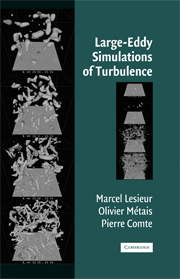1 - Introduction to LES
Published online by Cambridge University Press: 06 July 2010
Summary
Book's scope
Large-eddy simulations (LESs) of turbulent flows are extremely powerful techniques consisting in the elimination of scales smaller than some scale Δx by a proper low-pass filtering to enable suitable evolution equations for the large scales to be written. The latter maintain an intense spatio-temporal variability. Large-eddy simulation (LES) poses a very difficult theoretical problem of subgrid-scale modeling, that is, how to account for small-scale dynamics in the large-scale motion equations. LES is an invaluable tool for deciphering the vortical structure of turbulence, since it allows us to capture deterministically the formation and ulterior evolution of coherent vortices and structures. It also permits the prediction of numerous statistics associated with turbulence and induced mixing. LES applies to extremely general turbulent flows (isotropic, free-shear, wall-bounded, separated, rotating, stratified, compressible, chemically reacting, multiphase, magnetohydrodynamic, etc.). LES has contributed to a blooming industrial development in the aerodynamics of cars, trains, and planes; propulsion, turbo-machinery; thermal hydraulics; acoustics; and combustion. An important application lies in the possibility of simulating systems that allow turbulence control, which will be a major source of energy savings in the future. LES also has many applications in meteorology at various scales (small scales in the turbulent boundary layer, mesoscales, and synoptic planetary scales). Use of LES will soon enable us to predict the transport and mixing of pollution. LES is used in the ocean for understanding mixing due to vertical convection and stratification and also for understanding horizontal mesoscale eddies. LES should be very useful for understanding the generation of Earth's magnetic field in the turbulent outer mantle and as a tool for studying planetary and stellar dynamics.
- Type
- Chapter
- Information
- Large-Eddy Simulations of Turbulence , pp. 1 - 20Publisher: Cambridge University PressPrint publication year: 2005



